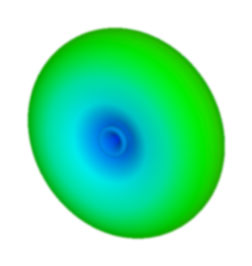Typical Application
- Indoors, set-top, suitable for strong local signals with minimal multi-path.
Size
- Rabbit ears can be up to about 80" across if fully extended horizontally. If set up in a "V" configuration, they can reach up to about 40" high.
- Loops are typically about 8" across, but if they are enclosed in plastic, it may appear to be bigger.
Operating Frequencies
- Rabbit ears (when extended) are good at handling VHF
- Loops are good at handling UHF
Gain
- Rabbit ears typically get close to 0 dBd if they are extended to the proper length (almost an ideal dipole). If set up in a "V" configuration, the gain is a little less, but then doesn't require as much horizontal space in your living room. The peak of the gain curve can be optimized for different channels by changing the length of the elements. Longer antenna elements (fully extended) favor lower channel numbers and shorter elements (about half extended) favor higher ones.
Rabbit Ears (this graph is for elements extended about 40", the gain peak can be moved to higher channels by shortening the elements)

- Loops typically get between -2 and +2 dBd at different points within the UHF band. If the antenna has a user-selectable tuning circuit (typically a multi-position switch on the base), it may be possible to move the peak of the gain curve to higher or lower frequencies, depending on which channel you want to watch.
Loop

Aiming
- Rabbit ears are optimally aimed by making the broad side of the antenna face the transmitter. That is, if you imagine the signal coming from the transmitter, you want it to come in perpendicular to the rabbit ear elements. The gain is roughly the same from the "front" or the "back", so either side will work.
Rabbit Ears in horizontal configuration

Rabbit Ears in "V" configuration

- Loops should be aimed so that the face of the loop is pointed at the transmitter. That is, the axis going through the center of the loop should aligned with the transmitter's direction. The gain is roughly the same from the "front" or the "back", so either side will work.
Loop
